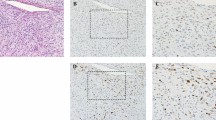Abstract
In 45 osteosarcoma patients, mean age 18 (4–61) years and followed for 14 (5–48) months, we studied the sensitivity to doxorubicin as well as P-glycoprotein expression, and compared these with the extent of tumour necrosis following chemotherapy. Doxorubicin assay was positive in 37 patients in whom necrosis induced by chemotherapy was good in 20 and poor in 17. Metastases developed in nine patients. In eight patients in whom doxorubicin assay indicated tumour resistance, chemonecrosis was poor and all developed pulmonary metastases. P-glycoprotein was studied in pre-treatment biopsies and post-treatment resection specimens. Its expression was positive in 16 patients in whom the necrosis induced by chemotherapy was good in four and poor in 12. In 29 patients with negative P-glycoprotein expression, necrosis was good in 16 and poor in 13. The doxorubicin sensitivity had a high correlation with chemonecrosis (P=0.006) and the incidence of metastases (P<0.001). However, P-glycoprotein expression at the time of diagnosis did not correlate statistically with chemonecrosis (P=0.066). Doxorubicin sensitivity prior to treatment is a better determinant of the response to chemotherapy and clinical outcome than is the P-glycoprotein expression.
Résumé.
Sur 45 patients atteints d'ostéosarcome, âgés de 18 (4–61) ans et suivis pendant 14 (5–48) mois, nous avons étudié la sensibilité à la doxorubicine et l'expression de la P-glycoprotéine, en comparant avec l'ampleur de la nécrose provoquée par la chimiothérapie. L'essai avec la doxorubicine était positif chez 37 patients, dont 20 avaient une bonne réponse, et 17 en avaient une mauvaise. Des métastases se sont développées chez neuf patients. Pour huit patients résistants à la doxorubicine, la nécrose tissulaire était limité et tous les patients ont développé des métastases pulmonaires. La P-glycoproteine a été étudiée dans les biopsies avant traitement et sur des échantillons de la résection. L'expression de la P-glycoprotéine était positive chez 16 patients. Douze patients ont montrés une faible nécrose et quatre une nécrose importante. Chez 29 patients sans expression de la P-glycoprotéine la nécrose était importante pour 16 et limitée pour 13. La sensibilité à la doxorubicine avait une haute corrélation avec la nécrose (P=0.006) aussi bien qu'avec la survenue de métastases (P<0.001). Cependant l'expression de la P-glycoprotéine à l'étape diagnostique n'a pas de signification statistique pour prédire la nécrose (P=0.066). La sensibilité à la doxorubicine testée avant traitement est un meilleur prédictif de la réponse à la chimiothérapie et du résultat clinique que la P-glycoprotéine.
Similar content being viewed by others
Author information
Authors and Affiliations
Corresponding author
Additional information
Electronic Publication
Rights and permissions
About this article
Cite this article
Kumta, S., Zhu, Q., Lee, K. et al. Clinical significance of P-glycoprotein immunohistochemistry and doxorubicin binding assay in patients with osteosarcoma. International Orthopaedics (SICOT) 25, 279–282 (2001). https://doi.org/10.1007/s002640100273
Accepted:
Published:
Issue Date:
DOI: https://doi.org/10.1007/s002640100273




